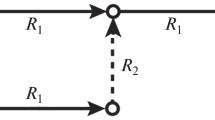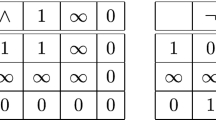Abstract
The central notion presented is that of closeness of (or difference between) two theories. In the first part, we give intuitive arguments in favor of considering topologies on the set of theories, continuous logics, and the average difference between two logics (i.e., the integral of their difference). We argue for the importance of the difference between theories in a wide range of applications and problems. In the second part, we give some basic definitions and results for one such type of topology. In particular, separation properties and compactness are discussed and examples given. The techniques employed for constructing the topology are also used for defining a σ-algebra of measurable sets on the set of theories, leading to the usual definition of the Lebesgue integral and a precise definition of the average difference of two logics.
Similar content being viewed by others
References
Birnbaum, L.: Rigor mortis,Artificial Intelligence 47 (1991), 57–77.
Dalal, M.: Investigations into a Theory of Knowledge Base Revisions: Preliminary Report,Proc. 7th Nat. Conf. AI, Minneapolis, 1988, pp. 475–479.
Engelking, R.:General Topology, Warsaw, 1977.
Halmos, P.:Measure Theory, New York, 1950.
Jech, T.:Set Theory, Academic Press, New York, 1978.
Kelley, J. L.:General Topology, Springer, Berlin, 1975.
Kraus, S., Lehmann, D., and Magidor, M.: Nonmonotonic reasoning, preferential models and cumulative logics,Artificial Intelligence 44(1–2) (1990), 167–207.
Lehmann, D. and Magidor, M.: What does a conditional knowledge base entail?,Artificial Intelligence 55(1) (1992), 1–60.
Michalski, R. S. and Winston, P. H.: Variable precision logics,Artificial Intelligence 29 (1986), 121–146.
Nilsson, N. J.: Logic and artificial intelligence,Artificial Intelligence 47 (1991), 31–56.
Schlechta, K.: Some results on classical preferential models,J. Logic and Computation 2(6) (1992), 675–686.




